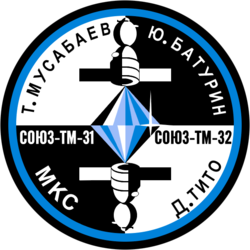List of Muslim astronauts


| Country | Name | Mission (launch date) | Insignia | Description |
|---|---|---|---|---|
| Sultan bin Salman Al Saud [1] | STS-51-G (June 17, 1985) | First Muslim, first Saudi, first Arab, first member of royalty in space. | ||
| Muhammed Faris [2] | Mir EP-1 (July 22, 1987) | First Syrian in space; second Arab in space. | ||
| Musa Manarov [3] | Mir EO-3 (December 21, 1987) Soyuz TM-11 (December 2, 1990) | First North Caucasian in space. Total of 541 days in space. | ||
| Abdul Ahad Momand [2] | Mir EP-3 (August 29, 1988) | First Afghan and Pashtun in space. | ||
| Toktar Aubakirov [2] | Soyuz TM-13 (October 2, 1991) | First Kazakh in space. | ||
| Talgat Musabayev [2] | Soyuz TM-19 (November 4, 1994) Soyuz TM-27 (August 25, 1998) Soyuz TM-32 (May 6, 2001) | Second Kazakh in space. Total of 341 days in space. | ||
| Salizhan Sharipov [2] | STS-89 (January 20, 1998) Expedition 10 (October 14, 2004) | First Tajik-Uzbek in space. Total of 201 days in space. | ||
| Anousheh Ansari | Soyuz TMA-9 (September 18, 2006) | First female space tourist; first Muslim woman in space; first Iranian in space. | ||
| Sheikh Muszaphar Shukor [2] | Soyuz TMA-11 (October 10, 2007) | First Malaysian Malay in space. | ||
| Aidyn Aimbetov [2] | Soyuz TMA-18M (September 2, 2015) | Third Kazakh in space. | ||
| Hazza Al Mansouri | Soyuz MS-15 (September 25, 2019) | First Emirati in space; third Arab in space. | ||
| Sara Sabry | Blue Origin NS-22 (August 4, 2022) | Suborbital flight. First Egyptian and African in space; first Arab woman in space; second Muslim woman in space. | ||
| Sultan Al Neyadi | SpaceX Crew-6 (March 2, 2023) | Second Emirati in space; fifth Arab in space. | ||
| Ali AlQarni | Axiom Mission 2 (May 21, 2023) | First male Saudi to ISS. | ||
| Rayyanah Barnawi | Axiom Mission 2 (May 21, 2023) | First Saudi woman in space; second Arab woman in space; third Muslim woman in space. | ||
| Namira Salim | Galactic 04 (October 6, 2023) | First Pakistani woman in space; First South Asian woman in space; fourth Muslim woman in space. | ||
| Alper Gezeravcı | Axiom Mission 3 (18 January, 2024) | First Turk in space and to ISS. | ||
| Tuva Cihangir Atasever | Galactic 07 (07 June, 2024) | Second Turkish-Azeri astronaut | ||
| Eiman Jahangir | Blue Origin NS-26 (29 August, 2024) |













